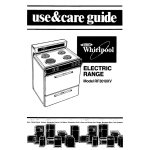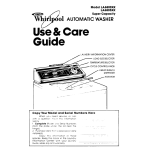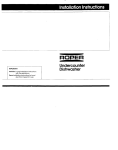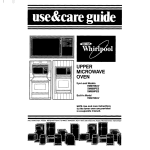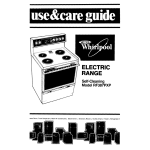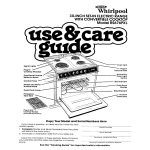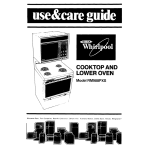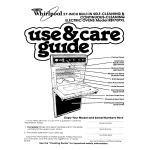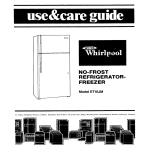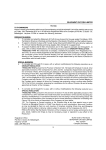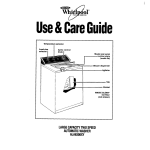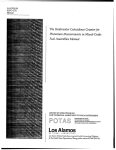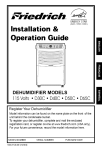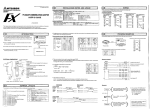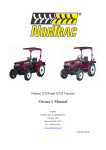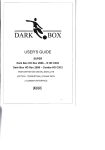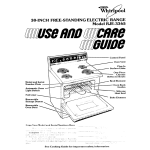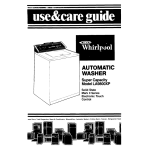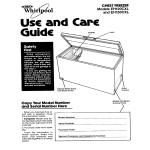Download COMMERCIAL AUTOMATIC WASHERS
Transcript
-. INSTALLATION INSTRUCTIONS COMMERCIAL AUTOMATIC WASHERS Proper Hot Water Temperatures Before you begin, be sure of . . . Electrical Requirements OBSERVE ALL GOVERNING . . . For best washing, your water heater should to the washer at 1 40° to 160’ Farenheit. provide water STANDARD BULKHEAD WIDTH p 151/4”-j . . . CODES AND ORDINANCES A 120 Volt, 60 Hz. AC only, 15 Amp fused electrical supply is required (time delay fuse or circuit breaker is recommended). It is recommended that a separate circuit serving only this appliance be provided. DO NOT use an extension Proper Plumbing cord . . . It is essential to have threaded faucets on hot and cold water outlets within 4 feet of the water inlets on back of washer. Provide a standpipe with a minimum diameter of 2 inches. Note: Any suitably trapped drain having away capacity of 17 gallons per minute quirements of the washer. Proper Drainage a minimum will meet I P 2” carrythe re- Note: . . . The drain hose must discharge into standpipe at a minimum height (from base of the washer) of 34” and a maximum height of 72”. It is recommended that the washers be installed on a concrete pad 2” above floor level. The overall width of a pad in a typical installation is 69”. A floor drain should be provided under the bulkhead. Prefabricated bulkheads with electrical outlets, water supply lines, and drain facilities should be used only for installations where codes permit. Proper Water Pressure Flush Out Water Supply Lines . . . Before installation, both hot and cold water supply lines should be flushed out to prevent sediment in lines from clogging screens in washer water valve. This is especially important in new construction. Now you are to begin . . . ready The necessary installation parts are packed inside washer basket . . two inlet hoses, one drain hose, two front leveling feet, two rear leveling legs, two hose clamps, two filter screens, four standard hose washers, and one ground wire assembly. . . . A minimum pressure of 10 PSI and maximum pressure of 100 PSI-dynamic is recommended for proper operation. A pressure reduction valve should be used in the supply line where inlet pressure entering the building exceeds 100 PSI to prevent damage to the machine mixing valve. If pressures are below 10 PSI-dynamic, long fill time will be evident. Proper 1 tools . . . no special tools are needed in most you need are such common tools as a installations; all screwdriver, pliers, and adjustable end wrench. Just follow these instructions step by step . . . 1. Remove CAUTION: Shipping 4. Shipping Accessories Do not grasp console to move Accessory appliance. After removing installation parts from the washer basket, re-tape the washer lid to prevent damage. Lay the washer on its back, using two packing carton corner supports for protection. Remove the foam plastic shipping block(3A) in the upper left hand corner. (See Figure 1 and 4.) COLD SHIPPING Figure Removal . . . Rear of appliance (See Figure 4.) Remove the rear service panel (1) first remove two screws at the bottom of the panel, then swing the panel up and toward you. Now remove the shipping blocks between the base plate and cabrnet, inside the left and right rear corners of the washer, by removinq the screws, washers and plastic spools (2). These assembliesare for protection of the washer during shipping. (See Figure 5.) Push base plate forward and remove the foam plastic block in the left corner (38). (See Figure 6.) Save all shipping accessories in the event the washer may be moved to another location. HOT 1 2. Rear Leg Assembly The two rear legs are self-leveling. from the parts bag. First remove the rear legs Take one of the rear leveling legs and align the flat portion of the leg so that it will fit into the hole in the lower channel of the leveling leg mechanism. See Figure 2A. Push up on the Figure 26. leveling leg until it snaps in place. See Figure 28 Figure 2A Repeat the previous steps with the remaining rear leveling leg. Then push up on one of the rear leveling legs. The other leg should go down. Next, push up on the leg that is down. This leg should move up and the one that was up should move down. If the leveling legs are not working properly, recheck to make sure you have followed the instructions. 3. Front Leg Assembly (See Figure 3.) By hand, turn each of the front leveling legs half way(up to the diamond marking on the threads) into the front cabinet gussets. Liquid detergent can be used to reduce the force needed to turn the legs into the gussets. Some legs may require the use of a suitable hand tool for installation. Note: Do not use oil or grease Now stand washer 23 -g J upright. ..’ I / WASHER BACK Figure 3 &d-&“lCE Figure 4 2 hgure 8 Figure 5 If necessary, shorten discharge hose (10) by cutting to fit installation. Avoid stretching or kinking. Also double check the internal drain hose (23) to make sure that it is not twisted or kinked. Be sure hose is secured to drain pipe and that it is above the normal water level of the washer to prevent siphoning. (Minimum height 34 inches, maximum height 72 inches from the base of the washer.) Note: Under no crrcumstances connected drrectly to the dram break IS provrded In accordance BE CAREFUL Now replace NOT may the drain hose be unless an adequate siphon wrth local plumbrng codes TO TWIST OR KINK ANY HOSES that came with the rear servrce panel Frgure 6 6. Hot Water Hose Assembly Be sure to use the new hoses and washers your new Whirlpool Washer. 5. Drain Hose Assembly (See Figure 4 & 7) From the inside, place plain end (no tabs) of the angle connector (8) through the lower hole in cabinet and snap in place. Position the angle connector from outside to face the standpipe. (See Figure 7.) Next, place the smaller hose clamp (9) on the internal drain hose (23). Remove plug from inside hose, then place the hose on the angle connector. Secure with hose clamp. Place the larger hose clamp (6) on the discharge hose tO8))and place on the angle connector. (See Figure 4 Film Insert one of the flat hose washers (14) and (16) into each end of one of the inlet hoses (See Figure 9). BE SURE WASHERS ARE SECURELY SEATED IN HOSE COUPLINGS. Attach one end of this hose (13) to the hot water faucet (17). Tighten coupling hand-tight, then an additional two-thirds turn with pliers. Attach the other end of the inlet hose (13) to the bottom port of the inlet valve (See “H” mark on cabinet for hot) (15). Tighten coupling hand-tight, then an additional two-thirds turn with pliers. DO NOT CROSS THREAD. 7 3 EXTERNAL GROUND WER SUPPLY GROUNDED COI LO WATER PIPE IREMOVE PAIN1 ‘, ETC.) 7. Cold Water Hose Assembly Be sure to use the new hoses and washers your new Whirlpool Washer. that came with Insert one of the flat hose washers (19) and (21) into each end of one of the inlet hoses (See Figure 9). BE SURE WASHERS ARE SECURELY SEATED IN HOSE COUPLINGS. Attach one end of this hose (18) to the cold water faucet (22). Tighten coupling hand-tight, then an additional two-thirds turn with pliers. Attach the other end of the inlet hose (18) to the top port of the inlet valve (See “C” mark on cabinet for cold) (20). Tighten coupling hand-tight, then an additional two-thirds turn with pliers. DO NOT CROSS THREAD. 8. Electrical Electrical IN0 is required on this * Grounded cold water pipe must have metal continuity to electrical ground and not be interrupted by plastic, rubber or other electrically insulating connectors (including water meter or pump) without adding a jumper wire at these connections. THE For your personal safety, this appliance must be grounded. This appliance is equipped with a power supply cord having a 3-prong ground plug. To minimize possible shock hazard, the cord must be plugged Into a mating 3-prong grounding type wall receptacle, grounded in accordance with the National Electrical Code and local codes and ordinances. If a mating wall receptacle is not available, it is the personal responslblllty and obligation of the customer to have a properly grounded 3-prong wall receptacle installed by a qualified electriclan. (See Figure 10 ). Coin Operated 9. Mechanism power Models Information supply cord before installing coin This washer is equipped with a meter case console, timer, selector switches and indicator lights. The coin slide mechanism, service lock and vault assembly can be supplied by the same source that supplied this washer. J-PRONG GROUNDING TYPE WALL RECEPTACLE POWER CORD Coin Disconnect mechanism. For added personal safety, using the clamp and green colored copper wire furnished, connect this separate ground wire (No. 18 minlmum) from the external ground connector on the back of the appliance to a grounded cold wa Ite!r pipe’. (See Figure 11 .) 3-PRONG GROUNDING PLUG 11 If this is done, you must connect a separate copper ground wire (No. 18 minimum) to a grounded cold water pipe* by means of a clamp and then to the external ground connector screw. Do not ground to a gas supply pipe. Do not connect to electrical supply until appliance is permanently grounded. appliance. A. RECOMMENDED GROUNDING METHOD DO NOT, UNDER ANY CIRCUMSTANCES, REMOVE POWER SUPPLY CORD GROUND PRONG. GROUND CLAMP MUST BE TIGHT ON PIPE Figure Connections ground WIRE 18 MlNlMUMl install the slide extension to the coin slide mechanism. To install the coin slide mechanism, remove the service door of the meter case. Lift the meter case top up at the back to remove. Carefully insert coin slide mechanism into opening and secure with the 3/16” bolt from inside meter case. (See Figure 12.) Note: The coin slide may have to be pushed in partially to gain clearance to install the coin slide mechanism. \ SUPPLY Figure This model is equipped with a security top lock concealed under the top, inside the meter case. Access to the lock is through the service door of the meter case. (See insert sheet for concealed top lock information.) 10 B. ALTERNATE GROUNDING METHOD DO NOT, UNDER ANY CIRCUMSTANCES, POWER SUPPLY CORD GROUND PRONG. REMOVE THE If changing and properly grounding the wall receptacle is impossible and where local codes permit (consult your elecirical inspector), a temporary adapter may be plugged into the existing 2-prong wall receptacle to mate with the 3-prong power supply cord. THIS, HOWEVER, IS NOT RECOMMENDED. Figure 12 4 Non-Coin Operated Models 10. Operation For all models, level washer from front to rear and from side to side by adjusting the front leveling feet until the water is level with the bottom row of holes around the basket. Information This washer is equipped with selector switches and indicator a console, lights. The rear legs are self-leveling and adjusted by tilting the washer forward and up approximately 1” in the rear, then releasing the washer so that the rear legs can settle themselves to a level position. push to start timer, The timer has a 9-l/2 minute wash cycle and can be operated manually, for service, from the rear of the console. The timer cycle information is ink stamped on the rear of the timer, a lever is attached to the rear of the timer shaft to manually position the timer through the cycle. 12. Timer Clutch Adjustment (If needed) All coin operated models have a timer that has a 9-l/2 minute wash in the Normal cycle. During the cycle check, actuate the coin mechanism and then check the wash cycle time. If the washer fails to start or does not give the proper wash cycle time, the clutch assembly may need adjustment as follows: To change cycle position, first stop the washer by pushing in on the lever from the rear, then reset lever to new cycle position and pull to restart the washer. (See Figure 13.) Note: The clutch assembly is equipped with a timer clutch adjustment screw. To adjust the adjustment screw, remove the timer from the meter case and adjust the timer clutch adjustment screw as follows: A. If the appliance fails to start after the coin slide mechanism has been fully actuated IN or OUT, a CLOCK-WISE adjustment of the screw is indicated. (See Figure 15.) B. If the appliance timer goes past the third increment of fill (less than 9-l/2 minutes of wash will occur in Normal cycle), turn the adjustment screw COUNTER-CLOCKWISE. (See Figure 15.) TIMER-REAR Figure 11. Leveling VIEW 13 Your Washer (All models) Now move the washer to its permanent operating location. Turn on the faucets and check for leaks, then fill the washer with water up to the bottom row of holes around the basket. Note: On coin operated models the timer may be turned by using the clutch assembly as a knob. Rotate the clutch assembly counter-clockwise until the washer starts to fill with water. When the proper water level is reached, slowly rotate the clutch assembly counter-clockwise until the “off” position is reached. (See Figure 14.) ROTATE COUNTERCLOCKWISE ONLY \ Figure 13. J -TIMER Figure 15 Make a Cycle Check (All models) Refer to the operating instructions and run the washer through one complete cycle. For coin-operated models the washer maybe operated manuallyascovered in the second paragraph under “Leveling Your Washer.” Use one-half the recommended amount of detergent. After the cycle, check all hoses and water connections to see that they are operating properly and that they do not leak. FF” 4 TIMER CLUTCH ADJUSTMENT SCREW FRONT 14 5 -. Important Information 1. Make sure proper electrical are blown. Operating the power supply cord IS plugged In and contact made Check fuses to be sure none 2. Make sure timer has been 3. Make sure water faucets 4. Make sure rnlet and dram 5. The washer 6. Excess suds cause “Suds Lock” slow sprn, and poor rtnsing. If sptnmng IS slow and excess suds are present, run the washer through a complete cycle without usng detergent. On future loads use less detergent or a controlled suds type detergent advanced to start are turned hoses 7. It IS recommended that fiberglass In cotn-operated washers If these type the washer, the washer must be run cycle to rtnse away any residue that washer from ftberglass Items cycle on are not Items not be washed rtemsare washed in through a complete might be left In the Do not use drycleaning flurds 8. CAUTION mable solvents In the automatic washer ktnked or other WIII not sptn 11 Ird IS open 9. Special Reminder Plan to place your Its Inlet valve IS protected from freezrng This chart gives examples of typical full washer loads ,j LOAD TYPE LOADING Mixed 2 4 6 6 2 2 6 Load Permanent Press SUGGESTION double or 1 king size sheet pillowcases T-shirts pair shorts shirts blouses handkerchiefs 1 double sheet 1 tablecloth 3 shirts 1 dress 1 blouse 2 slacks 2 pillowcases This washer provides cold water rinses, washer to provide warm water rinses: washer from electrical rear panel and insulated terminal 3. Install switch. wire 4. Reassemble console to terminal convert this supply. 2. Remove console red wire with the harness. brown-red to untape from the brownthe console J2 on cycle LOAD TYPE Heavy Knits Instructions for Converting from Cold Water Rinses to Warm Water Rinses 1. Disconnect flam- selection rear panel. 6 work clothes LOADING SUGGESTION 2 3 1 3 pair work pants work shirts coverall pair jeans 2 slacks 6 tops 4 shirts 2 dresses where Moving Operations Procedure 1. Turn off both 2. Start the washer 3. Turn off the washer. 4. Remove power rear of machine. 5. Remove inlet 6. Remove Inlet and place hoses 7. Remove KINK ) drain 8. Lay washer they are flush water 9. Pull downward on each of the rear they are free of the leveling foot channel. faucets. in the fill portion plastic foam 1 and 6 (3A & 36). hoses from hoses from In basket. hose, wall socket, coil and tape hot and cold water water inlet valve. to faucets. Wrap in upright 12. Remove servrce 13. Install ends coil and place on Its back and turn front with cabrnet. In basket (DO NOT levelrng feet until Showing 15. Tape rear nylon spool rear and bolts MINIMUM NOTE: Upon reinstallation and screen washers with .---I----------- \\I (2). Figure is now ready of machine, new. Typical I! 5 for shipment replace COPPER GROUND WIRE (NO. 18 MINIMUM) INLET 1 - I 4 hose assembly must fit in the standpipe so that there is an air gap around hose inside the standpipe. A snug fit can cause a siphoning action. FOR COMPLETE SERVICE WHIRLPOOL COMMERCIAL used hose Assembly ET * The drain drain (Do notgraspconsole.) 1 COLD WATER INLET L F,, HOT WATER INLET DRAIN* 2” MINiiiiUM/ ’ STANDPIPE I t FOR 1 MACHINEA in Figures 12” MINIMUM I, I I as shown panel \ ELECTRICAL 34” 72” until panel Washer ON SINGLE UNIT OPERATION INSTALLATIONS USE RISER TO PREVENT AIR HAMMER. IT SHOULD BE OF SAME SIZE PIPE AS OUTLET. RISER PROVIDES AN AIR CUSHION WHICH PREVENTS NOISE AND DAMAGE TO VALVES. blocks position. servrce lid closed Complete 120 VOLT, 3-PRONG RECEPTACLE (15 AMP) shipping 11. Place washer 14. Reinstall Illustration feet of the wash cycle. 10. Replace cord from leveling INFORMATION, AUTOMATIC 7 the BE SURE TO READ THE WASHER SERVICE MANUAL Benlon Harbor. Michigan. Aulomalic Washers. Clolhes Dryers. Freezers. Relrigeralor-Freezers. Ice Makers. Dishwashers. Buill-in Ovens and Surlace Units. Ranges. Microwave Ovens. Compactors. Room Air Condilioners. Oehumidiliers. Cenlral Healing and Air Conditioning Systems. Quality. Our way of life. Part No. 372073 Rev. A PrInted 8 I” U S A








